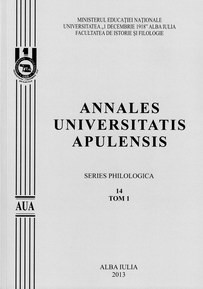Presa orădeană interbelică şi apropierea româno-maghiară
Oradea Interwar Press and the Romanian-Hungarian Approach
Author(s): ENIKO OlcarSubject(s): Cultural Essay, Political Essay, Societal Essay
Published by: Universitatea »1 Decembrie 1918« Alba Iulia
Keywords: Oradea press; interwar period; cultural approach; Romanian-Hungarian relations
Summary/Abstract: After the cataclysm of World Warr I, interwar press gave a large interest to cultural, literary and artistic life, numerous publications including in their program also the idea of twinning between different nationalities. Continuing the tradition of Iosif Vulcan and Ady Endre, Oradea Mare distinguished by a series of experiments for the implementation of cultural proximity. Under the leadership of George Bacaloglu the magazine ,,Cele trei Crişuri” and the department ,,Crişul Alb” of ,,Reuniunii Cele Trei Crişuri” have appeared in order to intensify the exchange of values between Romanian and Hungarian literatures. The magazine originally appeared in Oradea Mare, bimonthly, between April 15, 1920- December 1940 and then in Bucharest from 1941 to 1944 under the leadership of Roman Ciorogariu, George Bacaloglu , Al. Pteancu also frequently published translations of Hungarian literature, review volumes and the magazine of hungarian magazines. The survey organized by ,,Cele trei Crişuri” desire a fruitful cultural collaboration, managing to unite responses signed by writers, historians, publicists and politicians. Under the echo of ,,Clarté” movement founded in 1919 and coordinated by the french writer Henri Barbusse, in Oradea Mare appeared between December 24, 1922 and June 15, 1923 ,,Aurora” bilingual magazine written in Romanian and Hungarian, subtitled ,, Literary, artistic, theatrical, social”- Irodalom, művészet, szinház, társadalom”. The magazine has promoted mutual translations, stimulating cultural proximity of Danubian peoples and Romanian-Hungarian relations, but did not hesitate apostrophizing political maneuvering or exposing Hungarian irredentism. In 1935 the spirit of Oradea manifested again . Under the leadership of M. G. Samarineanu, series III of the magazine” Family " continued the fight on two fronts: one part from the collaborators campaigning against Hungarian revisionism, others for the Romanian-Hungarian approach. The survey of 1935 should be consistent with national and international political situation, extremely tense, culture having the mission to build a bridge for people over revisionist Hungary and anti-revisionist Romania. The investigation was supported by officials, Romanian and Hungarian men of letters from Cluj and Oradea, being one of the most courageous and relevant cultural facts around and managing to publish relevant opinions signed by Hungarian writers in Romania and Hungary, alongside those of Romanian men of letters. Although the scheduled meeting did not take place, Hungarian minority writers have pursued projects initiated by the press despite the press from Oradea and the final results have deeply appreciated the gesture of Romanian intellectuals.
Journal: Annales Universitatis Apulensis. Series Philologica
- Issue Year: 14/2013
- Issue No: 3
- Page Range: 147-160
- Page Count: 14
- Language: Romanian

